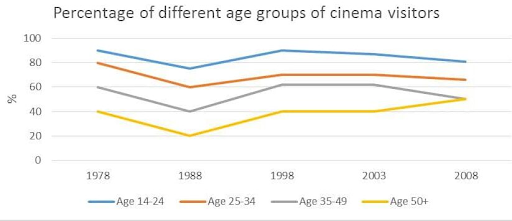The line graph shows the percentage of different age groups of cinema visitors in a particular country from 1978 to 2008.
Summarize the information by selecting and reporting the main features, and make comparisons where relevant. Write at least 150 words.

Lưu ý: Đề IELTS Writing Task 1 này lặp lại đề thi ngày 28/12/2022
Bài mẫu
The line graph delineates the changes in the proportion of moviegoers across four distinct age brackets in a specific nation from 1978 to 2008.
Overall, the younger demographic (14-24) displayed the greatest inclination toward cinema visits, contrasting to the scenario of the elderly. Notably, the propensity for moviegoing among the four age groups followed a similar trajectory from 1978 to 2003, but a marked deviation emerged post-2003.
Initially, the youngest cohort (14-24) demonstrated the highest affinity for cinema attendance, at 90%. The cinema patronage of the 25-34 age group was lower, with 80%, but it was still higher than the proportion of cinema-goers in the 35-49 category by 20% and twice as high as cinema attendance of the oldest age bracket (age 50+). During the first two decades of the period, all age categories exhibited parallel trends in cinema attendance: all showed a noticeable decline to approximately 75%, 60%, 40% and 20% respectively before a resurgence over the subsequent decade to the beginning points, barring the 25-34 age bracket whose figure was lower than 1978’s by 10%.
Thereafter, cinema visitor statistics of ages 14-24 and 35-40 dwindled to 80% and 50% by 2008 while the percentage of cinema-goers in the 25-34 category sustained the 70% rate until 2008. Conversely, individuals aged 50 and above exhibited a gradual rise in cinema attendance from 1998 to 2008, reaching 50%.
Từ vựng tốt trong bài
- Moviegoer (n): người đi xem phim ở rạp
Giải thích: a person who regularly goes to watch films at the cinema
Ví dụ: On both occasions he chose the wrong movies, for he was not a regular moviegoer.
- Propensity (n): thiên hướng, khuynh hướng
Giải thích: the fact that someone is likely to behave in a particular way, especially a bad way
Ví dụ: She’s inherited from her father a propensity to talk too much.
- Trajectory (n): quỹ đạo
Giải thích: the curved path that an object follows after it has been thrown or shot into the air
Ví dụ: My score seemed to be on a downward trajectory.
- Youngest cohort (n): nhóm hoặc tập hợp cá nhân trẻ nhất trong một dân số, thường được phân loại theo độ tuổi
Giải thích: the youngest group or set of individuals in a population, often categorized by age
Ví dụ: The kindergarten class represents the youngest cohort in the school, with most children aged 4 or 5.
- Affinity (n): thiên hướng thích cái gì
Giải thích: a liking or sympathy for someone or something, especially because of shared characteristics
Ví dụ: She was born in the country and had a deep affinity with nature.
- Oldest age bracket (n): nhóm tuổi cao nhất hoặc nâng cao nhất trong một dân số, thường được phân loại theo khoảng độ tuổi
Giải thích: the highest or most advanced age group within a population, often categorized by age ranges.
Ví dụ: The retirement community is primarily composed of individuals in the oldest age bracket, many of whom are enjoying their golden years after a lifetime of work.
- Exhibit parallel trends (v): thể hiện xu hướng tương đồng hoặc mô hình tương ứng trong một khoảng thời gian
Giải thích: to experience a similar trends/ changes
Ví dụ: The two economic indicators exhibit parallel trends, both showing consistent growth over the past five years.
- Show a noticeable decline (v): có sự suy giảm đáng kể
Giải thích: to clearly display a significant decrease or reduction
Ví dụ: The company’s quarterly report shows a noticeable decline in profits compared to the same period last year.
- Resurgence (n): nổi dậy
Giải thích: a new increase of activity or interest in a particular subject or idea that had been forgotten for some time
Ví dụ: The resurgence of violence is believed to be caused by criminals.
- Barring (preposition): ngoại trừ, trừ khi
Giải thích: except if a particular thing happens
Ví dụ: We should arrive at ten o’clock, barring any (= if there are no) unexpected delays.
- Dwindle (v): thu nhỏ lại, suy yếu dần
Giải thích: to become smaller in size or amount, or fewer in number
Ví dụ: Membership of the club has dwindled from 70 to 20.
- Exhibit a gradual rise (v): thể hiện sự tăng dần một cách chậm rãi theo thời gian
Giải thích: to display a slow and steady increase over time
Ví dụ: The temperature chart for the month exhibits a gradual rise, indicating a shift towards warmer weather.
Bạn đang chuẩn bị cho kì thi IELTS?
Hãy tham khảo Khóa Học IELTS Online qua ZOOM cùng cô Thanh Loan
IELTS Thanh Loan – giáo viên 10 năm kinh nghiệm – trực tiếp đứng lớp, tự tin mang đến khóa học chất lượng nhất, phương pháp giảng dạy cô đọng dễ hiểu, giáo trình tự biên soạn cho lộ trình từ cơ bản đến luyện đề chuyên sâu. Đặc biệt, học viên luôn được quan tâm sát sao nhất, hỗ trợ không giới hạn, thúc đẩy kỷ luật học tập tốt để đạt mục tiêu.

Lược dịch tiếng Việt
Biểu đồ đường mô tả những thay đổi về tỷ lệ người xem phim ở bốn độ tuổi khác nhau ở một quốc gia cụ thể từ năm 1978 đến năm 2008.
Nhìn chung, nhóm nhân khẩu học trẻ hơn (14-24) thể hiện xu hướng đi xem phim nhiều nhất, trái ngược với tình hình của người lớn tuổi. Đáng chú ý là xu hướng đi xem phim của bốn nhóm tuổi đi theo quỹ đạo tương tự từ năm 1978 đến năm 2003, nhưng có sự sai lệch rõ rệt sau năm 2003.
Ban đầu, nhóm trẻ nhất (14-24) thể hiện mức độ yêu thích xem phim cao nhất, ở mức 90%. Tỷ lệ đi xem phim của nhóm tuổi 25-34 thấp hơn, đạt 80%, nhưng vẫn cao hơn tỷ lệ khán giả xem phim ở nhóm tuổi 35-49 tới 20% và cao gấp đôi so với tỷ lệ đi xem phim của nhóm tuổi già nhất. (tuổi 50+). Trong hai thập niên đầu của thời kỳ, tất cả các nhóm tuổi đều thể hiện xu hướng tương đồng về lượng người xem phim: tất cả đều giảm đáng kể về mức khoảng 75%, 60%, 40% và 20% tương ứng trước khi phục hồi lại điểm xuất phát trong thập kỷ tiếp theo, ngoại trừ nhóm tuổi 25-34 có con số thấp hơn so với năm 1978 là 10%.
Sau đó, số liệu thống kê về khách xem phim ở độ tuổi 14-24 và 35-40 giảm xuống còn 80% và 50% vào năm 2008 trong khi tỷ lệ người đi xem phim ở nhóm 25-34 duy trì ở mức 70% cho đến năm 2008. Ngược lại, nhóm tuổi từ 50 tuổi trở lên cho thấy lượng người xem rạp tăng dần từ năm 1998 đến năm 2008, đạt 50%.
Nên luyện IELTS Writing ở đâu?
Cuốn sách với hơn 100 bài mẫu IELTS Writing Task 1 & 2 band 7.0+
Giá chỉ bằng 3 cốc trà sữa, nhưng bạn có:
1, Tổng hợp đề thi THẬT của các năm trước nên có tỉ lệ xuất hiện lại rất cao
2, Phân tích câu hỏi và gợi ý bố cục bài viết , cách phát triển ý, cùng bài mẫu chất lượng
3, Giải thích từ vựng tốt sử dụng trong bài và bản tạm dịch tiếng Việt

Xem thêm:












